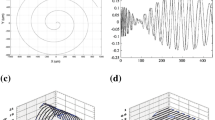Abstract
This paper presents a method, which enables a robot to extract demonstrator’s key motions based on imitation learning through unsegmented human motion. When a robot learns another’s motions from unsegmented time series, the robot has to find what he learns from the continuous motion. The learning architecture is developed mainly based on a switching autoregressive model (SARM), a simple phrase extraction method, and singular vector decomposition to discriminate key motions. In most previous research on methods of imitation learning by autonomous robots, target motions that were given to robots were segmented into several meaningful parts by the experimenters in advance. However, to imitate certain behaviors from the continuous motion of a person, the robot needs to find segments that should be learned. In our approach, the learning architecture converts the continuous time series into a discrete time series of letters by using SARM, finds candidates of key motions by using a simple phrase extractor which utilizes n-gram statistics, and removes meaningless segments from the keywords by utilizing singular vector decomposition (SVD) to achieve this goal,. In our experiment, a demonstrator displayed several unsegmented motions to a robot. The results revealed that the framework enabled the robot to obtain several prepared key motions.
Preview
Unable to display preview. Download preview PDF.
Similar content being viewed by others
References
Asada, M., MacDorman, K.F., Ishiguro, H., Kuniyoshi, Y.: Cognitive developmental robotics as a new paradigm for the design of humanoid robots. Robotics and Autonomous Systems 37(2-3), 185–193 (2001)
Inamura, T., Toshima, I., Tanie, H., Nakamura, Y.: Embodied symbol emergence based on mimesis theory. International Journal of Robotics Research 23(4), 363–377 (2004)
Kawashima, H., MAatsuyama, T.: Multiphase Learning for an Interval-Based Hybrid Dynamical System (Special Section Concurrent/Hybrid Systems: Theory and Applications). IEICE transactions on fundamentals of electronics, communications and computer sciences, 88
Murphy, K.P.: Switching Kalman filters. Dept. of Computer Science, University of California, Berkeley, Tech. Rep. (1998)
Sugiura, K., Iwahashi, N.: Learning object-manipulation verbs for human-robot communication. In: Workshop on Multimodal Interfaces in Semantic Interaction at the International Conference on Multimodal Interfaces (2007)
Tani, J., Ito, M., Sugita, Y.: Self-organization of distributedly represented multiple behavior schemata in a mirror system: reviews of robot experiments using RNNPB. Neural Networks 17(8-9), 1273–1289 (2004)
Taniguchi, T., Iwahashi, N.: Computational model of role reversal imitation through continuous human-robot interaction, pp. 25–31 (2007)
Taniguchi, T., Iwahashi, N., Sugiura, K., Sawaragi, T.: Constructive approach to role-reversal imitation through unsegmented interactions. Journal ref: Journal of Robotics and Mechatronics 20(4), 567–577 (2008)
Umemura, K.: Related word-pairs extraction without dictionaries. Technical report, IPA Exploratory Software Project development result report (2000) (in Japanese), http://www.ipa.go.jp/archive/NBP/12nendo/12mito/smdata/10-36h/10-36h.pdf
Author information
Authors and Affiliations
Editor information
Editors and Affiliations
Rights and permissions
Copyright information
© 2009 Springer-Verlag Berlin Heidelberg
About this paper
Cite this paper
Taniguchi, T., Iwahashi, N. (2009). Imitation Learning from Unsegmented Human Motion Using Switching Autoregressive Model and Singular Vector Decomposition. In: Köppen, M., Kasabov, N., Coghill, G. (eds) Advances in Neuro-Information Processing. ICONIP 2008. Lecture Notes in Computer Science, vol 5506. Springer, Berlin, Heidelberg. https://doi.org/10.1007/978-3-642-02490-0_116
Download citation
DOI: https://doi.org/10.1007/978-3-642-02490-0_116
Publisher Name: Springer, Berlin, Heidelberg
Print ISBN: 978-3-642-02489-4
Online ISBN: 978-3-642-02490-0
eBook Packages: Computer ScienceComputer Science (R0)




